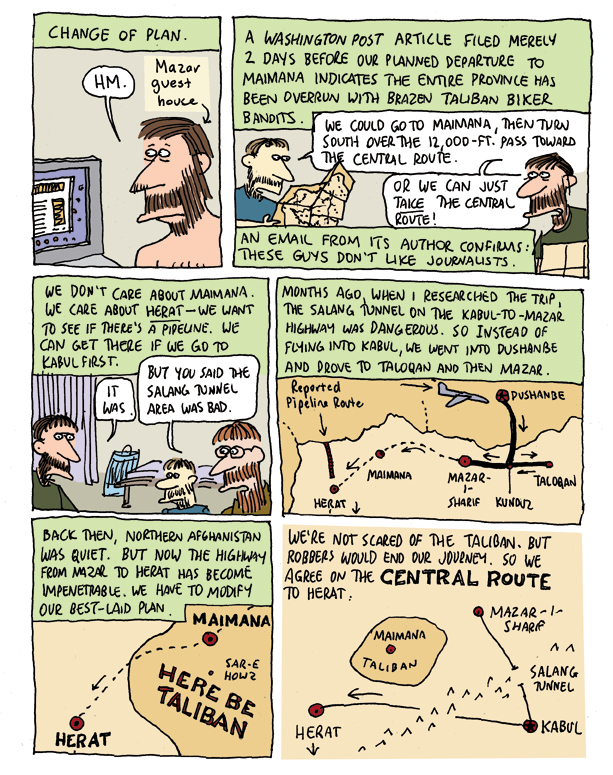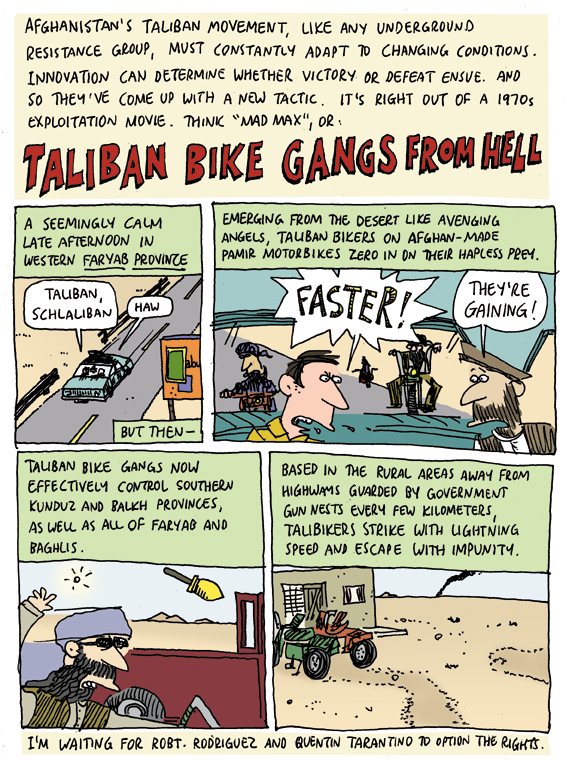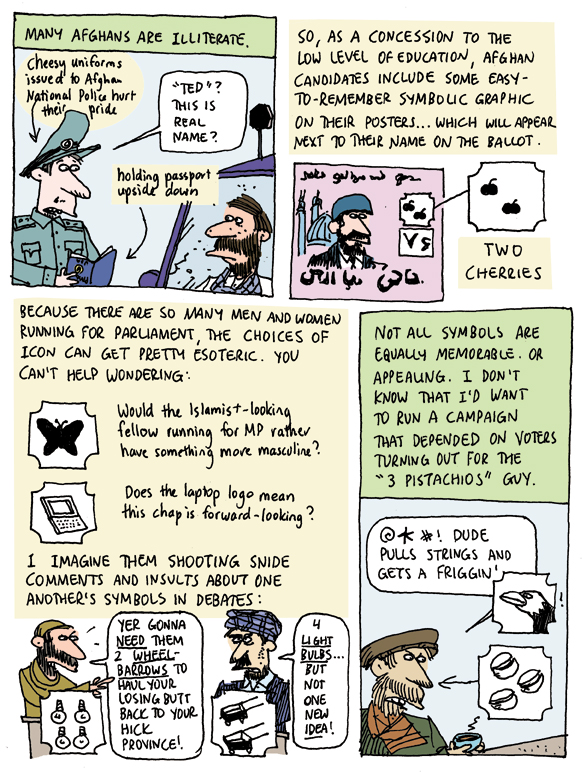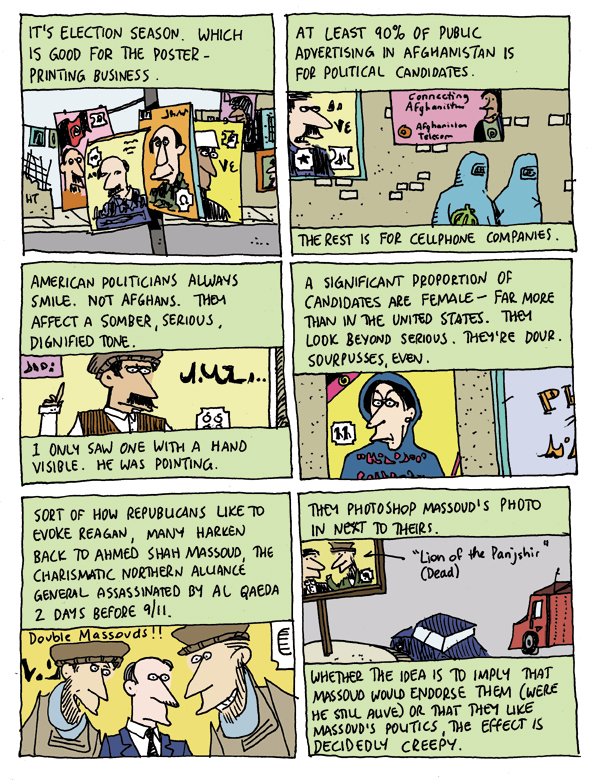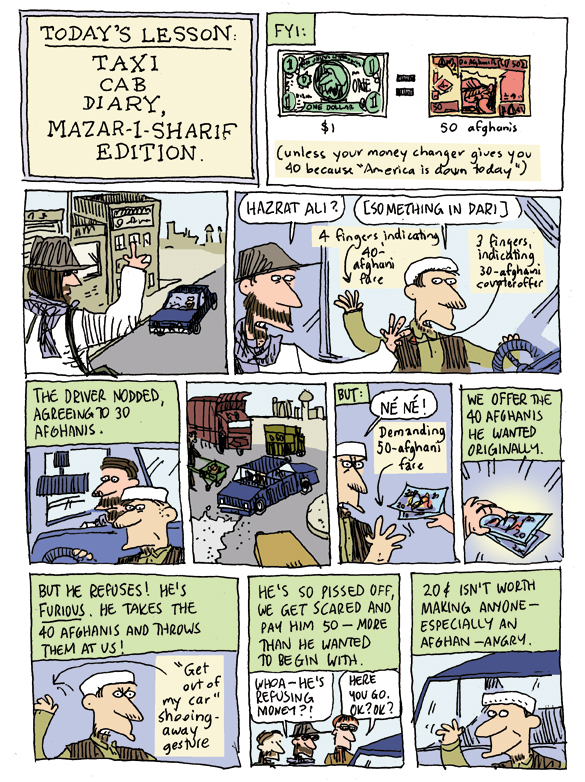SYNDICATED COLUMN: If I Die in Afghanistan
Please Spare Me the Hypocritical Obituaries
SOMEWHERE IN NORTHERN AFGHANISTAN—I am researching a book, a follow-up to “To Afghanistan and Back,” which in 2002 became the first book published about the U.S. invasion. Accompanied by fellow cartoonists Matt Bors and Steven Cloud, I am traveling from Kunduz to Heart via Mazar-i-Sharif and Mainana. By the time you read this, I should be about to turn south toward Zaranj, on the Iranian border.
Nimruz province is a challenging August vacation destination: lows in the 100s, highs in the 130s, scorpions and sporadic insurgent attacks at no extra cost. But political commentators have a duty to check things out for themselves. Sadly the U.S. doesn’t invade places like France and Italy anymore.
I could die.
I probably won’t. Thousands of Americans and other Westerners go to Afghanistan every year. Only a few get killed. But it is a dangerous place. The roads are awful. There are bandits. Everyone has guns. I’ve been shot at. Turn on a satellite phone, and you become a target for Predator drones. Did I mention scorpions?
The possibility of death is something you have to consider when you go to Afghanistan, especially when you leave Kabul. Last time around, three of my colleagues came back in coffins.
Yes, I’ll probably be fine. But if I die, I would like to ask my colleagues in the media—those assigned to write my obituary, should I be deemed to rate one—to spare me hypocritical bullshit praise.
I’m not talking about the hundreds of publications and broadcast outlets who have been kind to me over the years. I am amazed and humbled that anyone likes my stuff; I am still humbled when I see my name in print. I’m talking about the outlets that have always snubbed me.
Which is their right. Go ahead, snub like the wind! But don’t pretend you’re sad when I croak.
I don’t believe in an afterlife. Still, whatever remains of my spirit would be incredibly annoyed if The New York Times were to give me the Howard Zinn treatment. Zinn, the brilliant leftist historian who wrote “The People’s History of the United States,” was lauded both in a Times obit and an op-ed column by Bob Herbert.
When Zinn was still alive, however, you’d never know it by reading the Times. The Paper of Record repeatedly ran comments on political events from mainstream dullards, discredited neoconservatives and admitted plagiarists. They never ran Zinn. If they got reviewed at all, his books got short shrift. He was correct about most things, and thus too far left for the Times.
This is typical. Whenever an artist or writer tries to challenge the status quo, the establishment media boycotts his or her work. After they die (c.f. Lenny Bruce, George Carlin, Mickey Siporin) they get lionized.
As bad as it is for edgy cultural figures to be a victim of economic censorship, it sucks more to be dead. If they had any decency, the minions of the mainstream press would resist the temptation to steal your reflected (now safe in the grave) glory.
During the 1990s I was the most frequently reprinted political cartoonist in The New York Times. They ran my op-eds. Then 9/11 happened. Editors got scared. Publishers started sucking up to Bush and his right-wing supporters. I vanished from the print edition. Amusingly and Orwellianly, for several years, a black square appeared at NYTimes.com where my cartoons used to run.
I’m not whining. It’s their paper. If they want to publish the worst political cartoons in the country (ever Sunday in the Week in Review), they can.
But, Times editors, please don’t sing my praises in the obituaries. Don’t talk about how I was once the youngest syndicated cartoonist in the country, how I won a bunch of awards, how I helped revolutionize an art form, how my work was controversial and widely discussed, how cool it was that I went to Afghanistan and Central Asia. If you really thought I was great, you would have run my stuff. You didn’t. You thought I sucked. Or you didn’t have the guts to deal with angry readers.
Either way: shut the @#$% up.
This also goes for USA Today, which wallows in cartoon crapitude day after day. You never ran one of my cartoons. I’ve done more than 4,000 of them. Not one ever appeared in USA Today. Not one in 20 years. If you mention my death, please include an explanation of why I’m worth mentioning but not worth publishing.
If your explanation somehow involves peanut butter that would be cool.
Newsweek deserves special mention as well. Their weekly cartoon round-up is highly influential. Also, it sucks. Newsweek publishes the worst cartoons by the worst cartoonists. If I die in Afghanistan, one advantage of being dead will be that I never have to lay eyes on that p.o.s. again. They ran me one time. Once! And it was a terrible cartoon: as all political cartoonists know, a guy watching the news on TV is a lazy cliché.
Attention Newsweek editors: If you print an obit, and it says nice things about my work, I am totally going to haunt your lame asses.
Special you-ignored-me-my-entire-career-so-don’t-suck-up-after-I-die shoutouts also go to The Washington Post, which canceled me in response to a write-in campaign by right-wing extremists, and The San Francisco Chronicle, NPR, and every newspaper in my home state of Ohio. When I shed my mortal coil and shuffle off to the great open bar full of funny cartoonists and loose women in the sky, whenever that happens, I beg you to do me one last favor: say that I suck. Or, better yet, don’t mention me at all.
(Ted Rall is in Afghanistan to cover the war and research a book. He is the author of “The Anti-American Manifesto,” which will be published in September by Seven Stories Press. His website is tedrall.com.)
COPYRIGHT 2010 TED RALL
SYNDICATED COLUMN: Islamo-Gangsterism
In a Deteriorating Afghanistan, a New Breed of Terror
KABUL–“In squads of roaring dirt bikes and armed to the teeth,” Joshua Partlow reports in The Washington Post, “Taliban fighters are spreading like a brush fire into remote and defenseless villages across northern Afghanistan.”
Two other cartoonists and I were a day away from heading to Faryab–a remote, rural, Uzbek-dominated province in the northwest known for its brutally entertaining matches of buzkashi–when Partlow’s piece appeared. He described a phenomenon that deploys novel tactics out of a bizarre 1970s action flick.
It was years after the 2001 U.S. invasion before the Afghan national police began to take control of the country’s major highways. Now there are government-run gun nests every few kilometers.
Insurgents have responded to government control of the highways by basing themselves in rugged villages far away from the freshly-paved asphalt. Riding Pamir motorcycles supplied by Pakistani intelligence–thus paid for by American taxpayers–Taliban bike gangs swoop across the desert, taking one village after another.
“They move constantly on unmarked dirt roads outside the cities to ambush Afghan police and soldiers and to kidnap residents. They execute those affiliated with the government and shut down reconstruction projects,” wrote Partlow.
They now control every district in Faryab province, a vast region that borders Turkmenistan. But Afghan sources across the country say their reach is far broader. Talibikers control the center of the country in a north-south axis that begins with Faryab and Baghlis and runs all the way down to Helmand and Nimruz.
Their checkpoints and raids along the three main east-west traffic arteries have effectively bifurcated the country. Whether it’s government officials, members of NGOs or the media, you have to fly if you want to get from Kabul to Herat or vice versa.
Partlow’s article, and his personal feedback, prompted us to cancel our plan to travel to Herat via Faryab. We left Mazar-i-Sharif for Kabul. Now we’re looking for a driver willing to take us via the Central Route to Herat: a scenic, bucolic, previously calm stretch of unpaved road that begins at Bamiyan, site of the ruined Buddha statues, and runs west via Ghor province. So far, no luck.
“I wouldn’t take you there for $10,000,” is a typical response. “Why do you want to die?” runs second.
The average Afghan earns $40 a month.
South of Mazar we noticed our driver nervously scanning the desert. Several recently charred trucks testified to the presence of the Taliban. “The Taliban,” our driver said, “here they come on motorcycles.”
I asked: Even during the day?
“Even during the day,” he confirmed.
Like “Mad Max.”
What’s really worrisome is the behavior of these self-described Talibs. Like the Taliban regime that ran Afghanistan from 1996 to 2001, they enforce an extreme form of Sharia law. In village after village, they have been stoning people accused of adultery and shooting those accused of working for the Karzai puppet regime. But the similarity stops there.
The first-gen Taliban led by Mullah Omar practiced what they preached. They were scrupulously honest. Living ascetic lives, they didn’t tolerate corruption or dishonesty among their own ranks.
The so-called neo-Taliban were the second generation: the madrassa kids, many of them orphans, who grew up in the refugee camps in Pakistan during the war. Less worldly and completely uneducated, this coarse bunch came to dominate the anti-U.S. resistance from 2003 to 2009.
Here comes Taliban Mark 3: the Taliban biker gangs from hell. They’re still radical Islamists. But they’re also gangsters, brazen thieves who have adopted the thuggish behavior of the warlord class during the so-called “mujahedeen nights” of the early 1990s.
These aren’t your father’s Taliban. They don’t follow the rules: certainly not the Koran.
Like the “moojs,” Talibikers set up checkpoints and ambush points to catch motorists. They’re yanked out of their cars, robbed at gunpoint, and sent on their way–if the victims are lucky. Many have been shot to death.
“Taliban” and “bandit”–once mutually exclusive, even opposite terms–are now used interchangeably.
Everyone expects the Taliban to control most, if not all, of Afghanistan by next year. Whether it happens then or it takes longer the question is, which Taliban? As the U.S. presence wanes and influence of the Karzai regime fades even further, I foresee a clash, perhaps even a civil war, between the “real Taliban” (sales pitch: we’re tough but honest) and these self-branded Talib-cum-robbers (motto: shut up and pay up).
In the meantime, this new breed of fanatically religious desperadoes goes to prove something Afghans have always known. As bad as things seem, they can always get worse.
(Ted Rall is in Afghanistan to cover the war and research a book. He is the author of “The Anti-American Manifesto,” which will be published in September by Seven Stories Press. His website is tedrall.com.)
SYNDICATED COLUMN: Different War, Same Situation
Nine Years Later, Afghan City is Buzzing But Still Menacing
TALOQAN, AFGHANISTAN–Nine years ago, when I was using this provincial Afghan capital as a base to cover the battle of Kunduz, Taloqan was a dangerous place with medieval charm. Donkey carts and horse-drawn carriages, their steeds decked out with red pom-poms, plied muddy ruts that passed as roads. The only motorized transport belonged to Western NGOs. Commerce consisted of a few sad huts you’d recognize as primitive convenience stores and an outdoor bazaar where 90 percent of economic activity was attributable to sales of opium paste.
In 2001 I wrote that good roads would change everything. And they have. Some time after 2005, when The New York Times reported that the U.S. hadn’t laid an inch of pavement in the entire country, road building happened–at least here in Takhar and in neighboring Kunduz province.
It’s impressive. Based on my 2001 experience and the absence of media reports that anything had changed, I had budgeted three to four days to travel from the Tajik border to Taloqan. Cruising down smooth two-lane highways at 80-plus mph–Afghan drivers apparently had a long-repressed need for speed–we made it in half an afternoon. Towers for high-tension conduits (the wires haven’t been strung yet) line the road, promising an electrified future.
The ghosts of ’01 are here–burned-out armored personnel carriers, lumps of earth where villages stood, tank treads used as speed bumps–but hard to find. Khanabad, the blood-soaked eastern front line during the battle of Kunduz, where my fellow journalist had the skin torn off his body by Taliban POWs using their bare hands, is a farm community marked by the kind of green-and-white reflectorized sign you’d see in the Midwest.
Most of Taloqan is paved. The donkeys and horses are gone. The soccer field used by the Taliban for stonings and by a Northern Alliance warlord as a helicopter landing pad is filled with kids playing on green grass. There are traffic jams (of cars and Indian-style motorized rickshaws) and white-gloved traffic cops to direct the mayhem. Business is booming. America is finished, but Taloqan is looking good.
Asphalt made a difference. But the basics–the social and political situation that in December 2001 prompted me to declare the U.S. occupation of Afghanistan doomed–remain the same.
Time magazine recently declared that the Taliban would sweep back into power after a U.S. withdrawal, brutalizing them and stuffing them back under burqas. But the Taliban never left. Neither did the repression. In Taloqan every woman but one wore the burqa, turning her head away so we couldn’t see her eyes through the netting as we passed.
Where are the Taliban? “They are all around us,” said my driver’s cousin, the campaign manager for a Canadian-Afghan actor running for parliament next month. “During the day, it is OK. They come at night.”
Indeed they do. The week before our arrival they stormed a small NATO garrison staffed by German troops at the airport here, killing seven. Cellphone signals go dead at night in deference to Taliban strictures.
In 2001 I stayed with a pharmacist in the center of town, across the street from the Red Crescent. Now Afghans are strictly prohibited from receiving foreigners as overnight guests. Only one hotel, the gaudy Ariana Hotel and Wedding Banquet Hall, can accommodate non-Afghans. “The situation in Taloqan is not good,” continued the campaign manager. “At night.”
We have the Ariana entirely to ourselves. Compared to the Spartan conditions we endured nine years ago–bed lice, outhouse guarded by a mean rooster–it’s a palace. Air conditioning, real beds, no parasitic bites as far as I can tell. There’s a generator to supplement the four hours a day of electricity supplied to the city.
But it’s a gilded cage, one surrounded by high walls topped with barbed wire and guarded by a caffeinated man brandishing an AK-47. We can’t go out at night, and neither do most Afghans. There’s more prosperity. But it’s even less safe.
Money is exchanging hands. But the one thing Afghans wanted most in 2001–security–remains elusive. Though it is not a historical novelty, it is ironic that people are turning to those who create the threat in order to resolve it.
(Ted Rall is in Afghanistan to cover the war and research a book. He is the author of “The Anti-American Manifesto,” which will be published in September by Seven Stories Press. His website is tedrall.com.)

